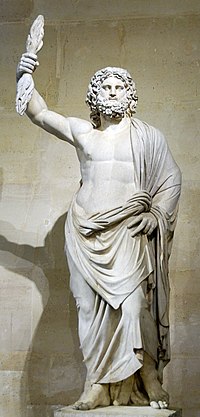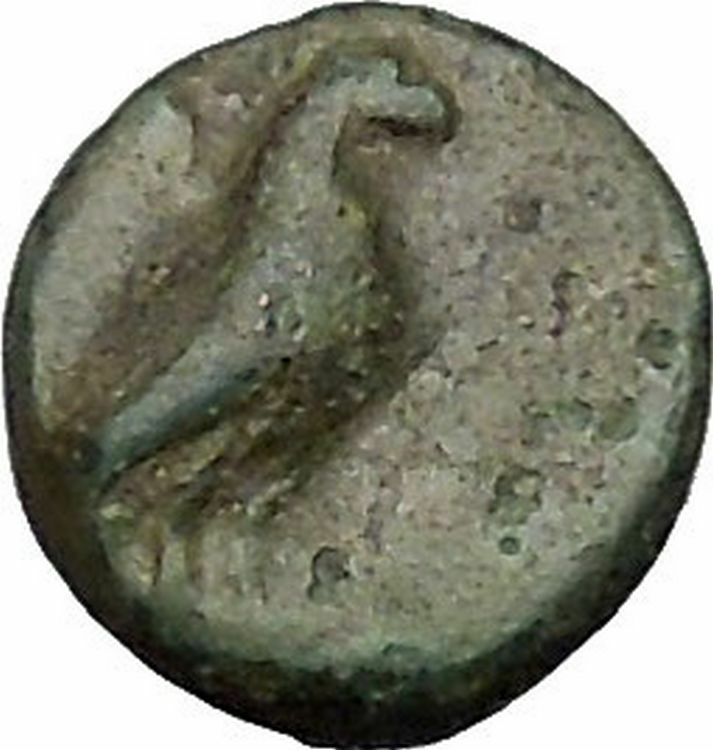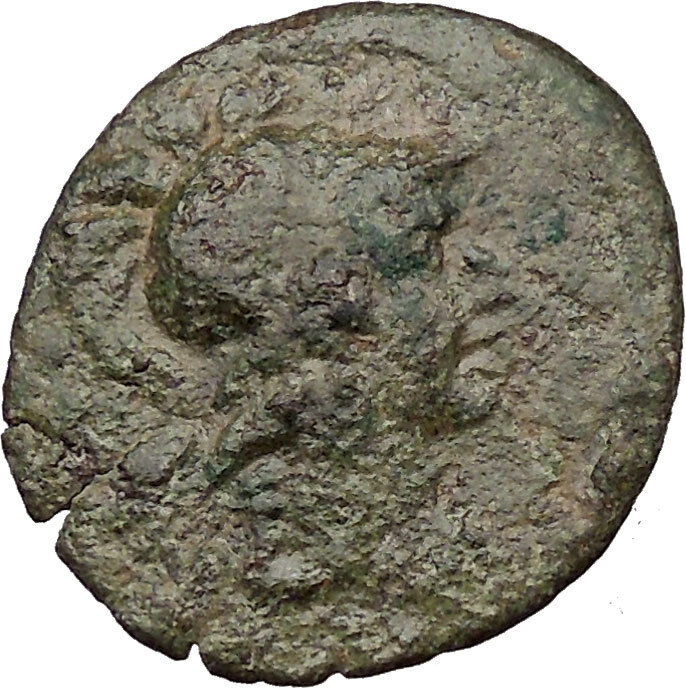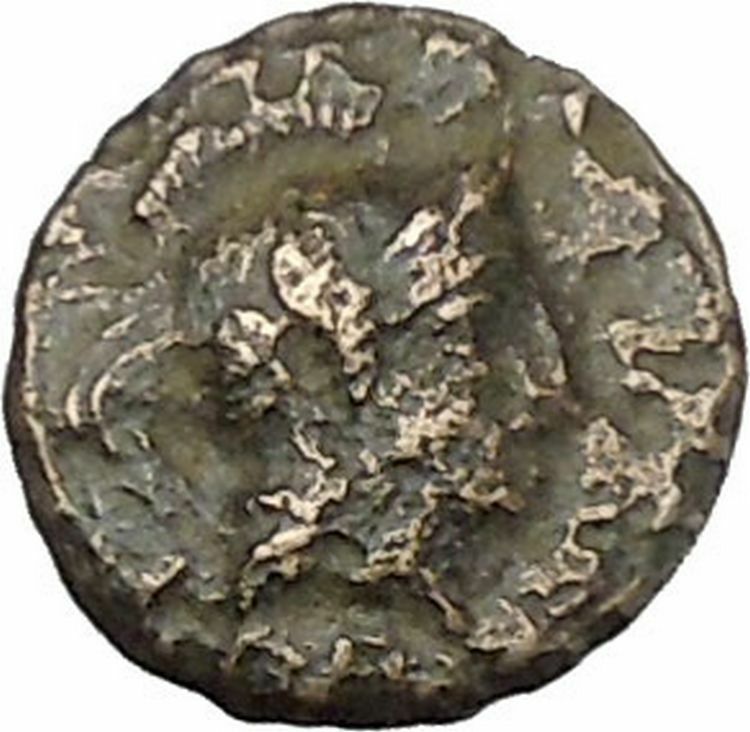|
Greek city of Seleukeia in Pieria “Brother Peoples”
Bronze 25mm (15.31 grams) Struck 149/148 B.C.
Reference: HGC 9, 1394 var. (EΞΡ) Rare R1
Jugate bearded heads right of the Demoi of Seleukia and Antioch wearing tainiai.
ΑΔΕΛΦΩΝ / ΔΗΜΩΝ, Zeus enthroned left, holding Nike and scepter; monograms in left and right fields; Seleukid era data ΔΞΡ.
Demoi stands for the people of Seleukeia and Antioch. This is a very are coin.
You are bidding on the exact item pictured, provided with a Certificate of Authenticity and Lifetime Guarantee of Authenticity.
 In the ancient Greek religion, Zeus was the “Father of Gods and men” who ruled the Olympians of Mount Olympus as a father ruled the family. He was the god of sky and thunder in Greek mythology. His Roman counterpart is Jupiter and Etruscan counterpart is Tinia. In the ancient Greek religion, Zeus was the “Father of Gods and men” who ruled the Olympians of Mount Olympus as a father ruled the family. He was the god of sky and thunder in Greek mythology. His Roman counterpart is Jupiter and Etruscan counterpart is Tinia.
Zeus was the child of Cronus and Rhea, and the youngest of his siblings. In most traditions he was married to Hera, although, at the oracle of Dodona, his consort was Dione: according to the Iliad, he is the father of Aphrodite by Dione. He is known for his erotic escapades. These resulted in many godly and heroic offspring, including Athena, Apollo and Artemis, Hermes, Persephone (by Demeter), Dionysus, Perseus, Heracles, Helen of Troy, Minos, and the Muses (by Mnemosyne); by Hera, he is usually said to have fathered Ares, Hebe and Hephaestus.
As Walter Burkert points out in his book, Greek Religion, “Even the gods who are not his natural children address him as Father, and all the gods rise in his presence.” For the Greeks, he was the King of the Gods, who oversaw the universe. As Pausanias observed, “That Zeus is king in heaven is a saying common to all men”. In Hesiod’s Theogony Zeus assigns the various gods their roles. In the Homeric Hymns he is referred to as the chieftain of the gods.
His symbols are the thunderbolt, eagle, bull, and oak. In addition to his Indo-European inheritance, the classical “cloud-gatherer” also derives certain iconographic traits from the cultures of the Ancient Near East, such as the scepter. Zeus is frequently depicted by Greek artists in one of two poses: standing, striding forward, with a thunderbolt leveled in his raised right hand, or seated in majesty.
Seleucia Pieria (Greek Σελεύκεια ἐν Πιερίᾳ, later Suedia) was a town in antiquity, the capital of Seleucus I Nicator. The city was built, a bit north of the estuary of the river Orontes, between small rivers on the western slopes of the Coryphaeus, one of the southern summits of the Amanus Mountains. The Macedonians called the landscape Pieria, after a district in their homeland that was also between the sea and a mountain range (the Olympus).
It functioned as the commercial and naval seaport of the western Seleucid capital of Antioch ad Orontes, present-day Antakya. According to Pausanias and Malalas, there appears to have been a previous city here named Palaeopolis (“Old City”). At present, it is located at the seaside village of Çevlik near the town of Samandağ in the Hatay Province of Turkey. Seleucia, Apamea, Laodicea, and Antioch formed the tetrapolis.
History
Seleucid period
Seleucia Pieria was founded in ca. 300 BCE by Seleucus I Nicator, one of the successors of the Macedonian conqueror Alexander the Great and the founder of the Seleucid Empire. Seleucia was of great importance in the struggle between the Seleucids and the Ptolemies; it was captured by Ptolemy Euergetes in 246 BCE. As the Ptolemies (Lagids) and Seleucids fought over the city, it changed hands several times until 219 BCE, when the Seleucid Antiochus III the Great recaptured it during the Fourth War (219-217 BCE). Then it obtained its freedom and kept it even to the end of the Roman occupation. It had long enjoyed the right of coinage.
 Column plinths of possibly the main/harbour street Column plinths of possibly the main/harbour street
Roman period
When the Seleucid Empire was subdued by the Armenian conqueror Tigranes II, Seleucia Pieria resisted. Roman general Pompey the Great restored the Seleucids to power by giving the city to Antiochus I Theos of Commagene, a direct descendant of Seleucus I Nicator and a loyal ally of Rome. Under light Commagene rule, Seleucia enjoyed substantial autonomy, i.e. de facto independence.
Seleucia’s importance grew significantly over time, necessitating the enlargement of its harbours several times under Diocletian and Constantius. These harbours, called the “inner” and “outer” harbours, served from time to time the Roman navy.
Most buildings and structures today date from the Roman period.
Byzantine period
During Byzantine times the city went into a steady decline. The silting up of the city’s harbours hastened this process. In the fifth century CE the fight to keep them open was finally given up. It suffered severely in the devastating 526 Antioch earthquake.
Islamic period
Seleucia was captured by the Sasanids around 540 CE. While it never recovered as a port-city again, Al-Walid ibn Abd al-Malik, Ummayad Caliph from 705-715, built a fortress in the city.
Seleucia Pieria and Christianity
The city was Christianized early. As the port of Antioch, “Seleucia on sea”-so called to distinguish it from other cities of the same name-is most notable as the precise point of embarkation from which the Apostle Paul [in 45 CE] and Saint Barnabas sailed from this port on their first missionary journeys, as chronicled in the Bible (Acts 13:4). At the end of that same journey he must have made landfall at Seleucia before going to Antioch (see Acts 14:26). His route at the beginning of the second journey was by land and probably bypassed Seleucia (see Acts 15:40-41), though on returning, he must have passed through it again (see Acts 18:22). Once more taking a land route when setting out on his third journey, Paul may have missed Seleucia (see Acts 19:1), and at that journey’s end he did not return to Antioch and so missed Seleucia again (see Acts 21:7-8). This means that Paul passed through Seleucia at least three times, and probably several more on pre-missionary visits to Antioch (see Acts 11:26; 12:25).
The oldest bishop known is Zenobius, present at the Council of Nicaea in 325 CE. Other known bishops include Eusebius, an Arian, and Bizus in the fourth century, with twelve others cited by Le Quien (Oriens Christianus, II, 777-780). In the sixth century CE the Notitia Episcopatuum of Antioch, gives Seleucia Pieria as an autocephalous archbishopric, suffragan of Antioch (Echos d’Orient, X 144); the diocese existed until the tenth century CE, and its boundaries are known (Echos d’Orient, X, 97). For some Roman Catholic titularies see Eubel, Hierarchia catholica medii aevi, I, 468.
 A section of the Titus Tunnel A section of the Titus Tunnel
Seleucia Pieria was a diocese of the Orthodox Church in the eighth and ninth centuries CE, three of whose bishops are known. The last-known Orthodox bishop of Seleucia, Ahron (847/874 CE), is mentioned in the lists of Michael.
The city is still a titular see of the Roman Catholic Church, Seleuciensis Pierius; the seat is vacant following the death of the last bishop in 1980.
Main Sites
The upper city, about 13 km in circumference, is still distinguishable. The lower city, smaller than the preceding one, was more thickly populated. Ruins include a necropolis, amphitheatre, citadel, temples, some irrigation works as well as some fortifications.
The highlight of the city is a 1350-1400m long tunnel/canal complex built during Roman times. It is believed that it was dug to divert the nearby river and prevent the harbour from silting up with time. A further reason is assumed to be to help reduce flooding caused during heavy winter rains. Construction began during the reign of Emperor Vespasian (69-79 CE) continuing mainly during his son Titus’s time (79-81 CE).
According to Flavius Josephus, a Roman-Jewish historian (37-ca.100 CE), Jewish slaves were used as workers. These were working under orders of Emperor Titus, aka Titus Tunnel, who had captured Jerusalem in 70 CE. Other POWs were sent to Rome, where they had to build the Colosseum. According to an inscription, the tunnel/canal was not completely finished until the reign of Antoninus Pius (138-161 CE). The last workers were Roman legionaries.
Most parts of the tunnel/canal are intact and it can be visited on foot. Rock tombs are found on the wall of the canal.
Notable persons
Famous residents include Apollophanes, a physician of Antiochus III the Great (third century), and Firmus who aroused Palmyra and Egypt against Rome in 272 CE.
|





 In the ancient Greek religion, Zeus was the “Father of Gods and men” who ruled the Olympians of Mount Olympus as a father ruled the family. He was the god of sky and thunder in Greek mythology. His Roman counterpart is Jupiter and Etruscan counterpart is Tinia.
In the ancient Greek religion, Zeus was the “Father of Gods and men” who ruled the Olympians of Mount Olympus as a father ruled the family. He was the god of sky and thunder in Greek mythology. His Roman counterpart is Jupiter and Etruscan counterpart is Tinia. Column plinths of possibly the main/harbour street
Column plinths of possibly the main/harbour street A section of the Titus Tunnel
A section of the Titus Tunnel




